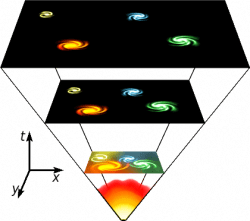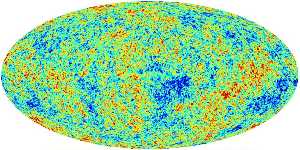Since there are stars and galaxies in all directions, why is space black? Shouldn’t there be a star in every direction we look?
Imagine you’re in space. Just the floating part, not the peeing into a vacuum hose or eating that funky “ice cream” from foil bags part. If you looked at the Sun, it would be bright and your retinas would crisp up. The rest of the sky would be a soothing black, decorated with tiny little less burny points of light.
If you’ve done your homework, you know that space is huge. It even be infinite, which is much bigger than huge. If it is infinite you can imagine looking out into space in any direction and there being a star. Stars would litter everything. Dumb stars everywhere wrecking the view. It’s stars all the way down, people.
So, shouldn’t the entire sky be as bright as a star, since there’s a star in every possible minute direction you could ever look in? If you’ve ever asked yourself this question, you probably won’t be surprised to know you’re not the first. Also, at this point you can tell people you were wondering about it and they’ll never know you just watched it here and then you can sound wicked smart and impress all those dudes.
This question was famously asked by the German astronomer Heinrich Wilhelm Olbers who described it in 1823. We now call this Olbers’ Paradox after him. Here let me give you a little coaching, you’ll start your conversation at the party with “So, the other day, I was contemplating Olbers’ Paradox… Oh what’s that? You don’t know what it is… oh that’s so sweet!”. The paradox goes like this: if the Universe is infinite, static and has existed forever, then everywhere you look should eventually hit a star.

Our experiences tell us this isn’t the case. So by proposing this paradox, Olbers knew the Universe couldn’t be infinite, static and timeless. It could be a couple of these, but not all three. In the 1920s, debonair man about town, Edwin Hubble discovered that the Universe isn’t static. In fact, galaxies are speeding away from us in all directions like we have the cooties.
This led to the theory of the Big Bang, that the Universe was once gathered into a single point in time and space, and then, expanded rapidly. Our Universe has proven to not be static or timeless. And so, PARADOX SOLVED!
Here’s the short version. We don’t see stars in every direction because many of the stars haven’t been around long enough for their light to get to us. Which I hope tickles your brain in the way it does mine. Not only do we have this incomprehensibly massive size of our Universe, but the scale of time we’re talking about when we do these thought experiments is absolutely boggling. So, PARADOX SOLVED!
Well, not exactly. Shortly after the Big Bang, the entire Universe was hot and dense, like the core of a star. A few hundred thousand years after the Big Bang, when the first light was able to leap out into space, everything, in every direction was as bright as the surface of a star.

So, in all directions, we should still be seeing the brightness of a star.. and yet we don’t. As the Universe expanded, the wavelengths of that initial visible light were stretched out and out and dragged to the wide end of the electromagnetic spectrum until they became microwaves. This is Cosmic Microwave Background Radiation, and you guessed it, we can detect it in every direction we can look in.
So Olbers’ instinct was right. If you look in every direction, you’re seeing a spot as bright as a star, it’s just that the expansion of the Universe stretched out the wavelengths so that the light is invisible to our eyes. But if you could see the Universe with microwave detecting eyes, you’d see this: brightness in every direction.
Did you come up with Olbers’ Paradox too? What other paradoxes have puzzled you?


a nice explanation of the paradox, good work!
i have a question though: can we be absolutely sure of the assumption that there is a star somewhere along the line in any direction we look at? can we be absolutely certain that there is no single point in the sky in which direction there are no stars whatsoever, regardless of the distance we’d look? (just curious, the paradox and the cmb observation still get most of the sky covered by a star somewhere)